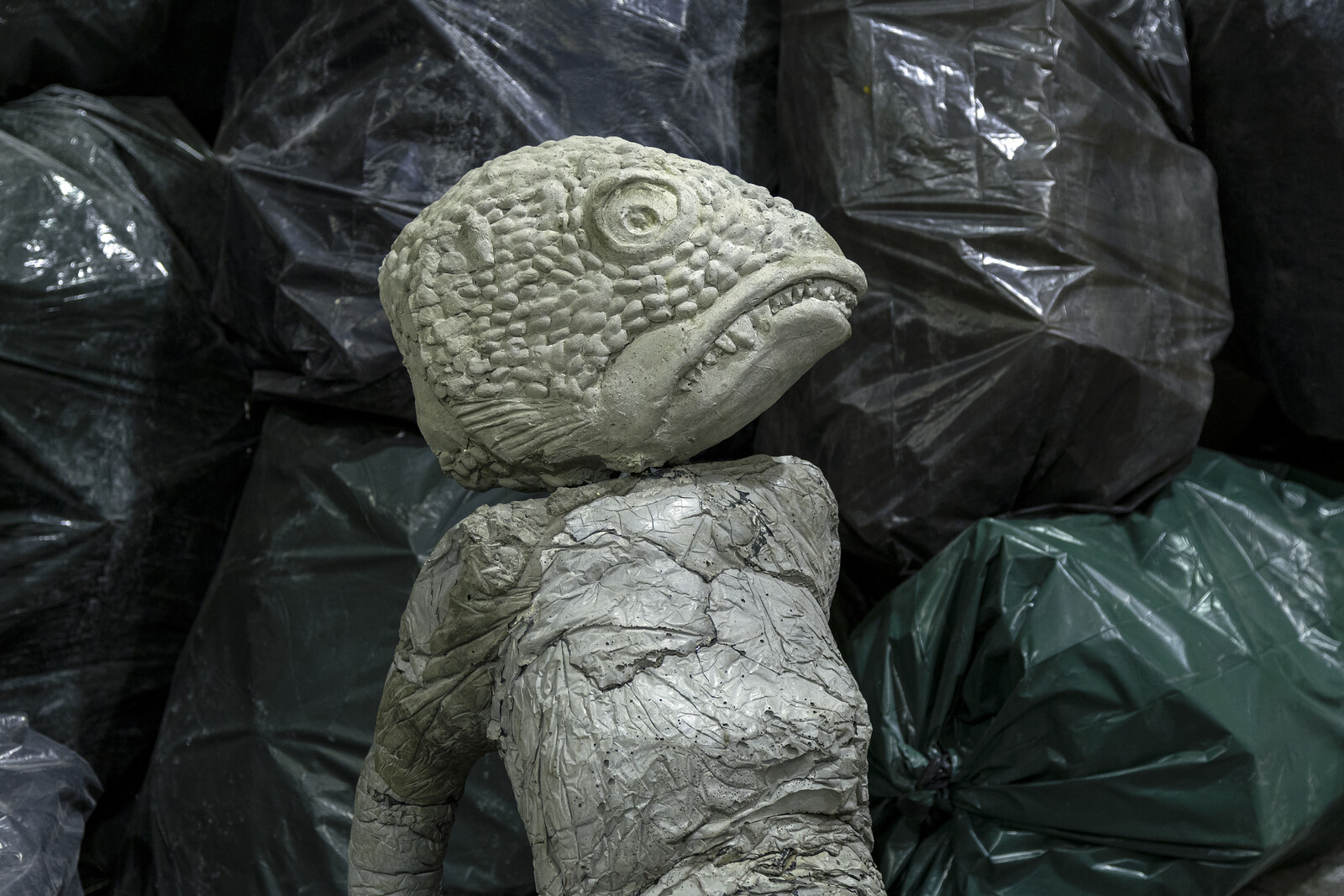Hora lupi
April 20–November 24, 2024
Edith Karlson will present Hora lupi for the Estonian Pavilion at the 60th International Venice Biennale from April 20 until November 24, 2024. Presented at the church of Chiesa di Santa Maria delle Penitenti, the exhibition explores primitive human urges in their banality and solemnity and questions the possibility of redemption in a world that is never worthy of it.
Located in Cannaregio overlooking the district’s canal, the arresting interior of the church, which dates back to the 18th century, helps to build the emotional atmosphere of the exhibition. Here, everything is left unchanged, even the dust of the centuries past remains. Lying in abandonment, Karlson uses the space as a metaphor for being human, equally sad, and incomplete. Full of cracks and fissures, through which eventually, perhaps, a redeeming light will shine. The exhibition spaces are filled with clay and concrete sculptures that evoke the inevitable misfortune of being born, and the always-endeavouring nature of being human.
The title of the exhibition Hora lupi (hour of the wolf) refers to a mythical time before dawn, when things arise and disappear—an hour of deep darkness but also of transformation. It is believed to be the time of night, when the most people are born and die. The exhibition centres around a vast series of hand-crafted clay self-portraits created by people who surround the artist: children and elderly people, state officials and common workers—a gallery of contemporary faces that will someday become their memorial. The sculptures are inspired by the 14th century terracotta sculptures in St. John’s Church in Tartu, Estonia, most likely depicting townspeople of the time. It has been suggested that the sculptures are a memorial ensemble commemorating the victims of the plague.
Sculptures by Karlson reside in the remaining rooms of the church, including the artist’s recognisable anthropomorphic figures inspired by folklore and mythology: as waves from passing vaporetti gently crash through a gaping hole in the collapsed floor, we see weremermaids perched on the verge of its opening.
For Hora lupi, Karlson presents an existential narrative of the animalistic nature of humans. Depicting that the sincerity and bluntness of instinct can sometimes take a brutal and violent form, but also poetic and at times a little absurd, gentle, and melancholy. So, by and large, the theme of the exhibition for the Estonian Pavilion at La Biennale Arte 2024 could be concluded as “our world today”.
About Edith Karlson
Edith Karlson is a sculptor who often presents her work as installation, using an entire exhibition space. Her works tackle the most inexplicable feelings and sensations in the current world: fear, melancholy, brutality and joy, which she transforms into material form, often in clay, concrete or found materials. Frequently working with animal forms and anthropomorphic figures, she approaches humans as animalistic beings whose impulses, wants, and desires are hidden just under the surface of their well-pressed suits.
Karlson studied installation and sculpture at the Estonian Academy of Arts (BA, 2006; MA, 2008). She was awarded the EAA Young Artist’s Prize (2006) and Köler Prize People’s Choice Award (2015). Karlson is among the recipients of the national artists’ salary between 2018-2020 and 2022-2024 and was granted the Estonian Cultural Endowment’s main award (2021).
About Eero Epner
Eero Epner is an art historian, dramaturge and writer who has worked for the avant-garde theatre NO99 as well as with many Estonian artists. He worked with Edith Karlson for her last large-scale show The Return of the Innocence (Estonian Contemporary Art Museum, 2021). He was granted the Estonian Cultural Endowment’s award for researching and introducing the works of Konrad Mägi, an Estonian artist from early 20th century in 2017.
Participating since 1997, this is the 14th time Estonia is exhibiting at the Venice Biennale. The Estonian Centre for Contemporary Art is the official representative of the Estonian exposition and it is financed by Estonian Ministry of Culture.
Commissioner: Maria Arusoo (Estonian Centre for Contemporary Art, CCA)
Dramaturge: Eero Epner
Graphic designer: Jojo & me (Johanna Ruukholm and Martina Gofman)
Communication team: Kaarin Kivirähk (CCA), Keiu Krikmann (CCA), Stina Pley, Alexia Menikou
Head of production: Sten Ojavee (CCA)
Project coordinators: Mikk Lahesalu (CCA), Marika Agu (CCA)
Technical team: Tõnu Narro and Mihkel Lember (Technical Director), Johannes Säre (Dream Team)
Artist’s team: Art Allmägi, Sander Haugas, Kristi Kaubi, Loora Kaubi, Ats Kruusing, Erik Liiv, Maria Luiga, Eva Mahhov, Liisi Põllumaa, Nikolai Saaremets, Elo Vahtrik, artist’s dogs Iti and Kusti
Architect: Piero Vespignani
Italian coordinator: Valeria Romagnini
For information about the Estonian Pavilion for 2024, please contact international PR advisor Alexia Menikou: am [at] alexiamenikou.com / T +44 (0) 7958 454 111



